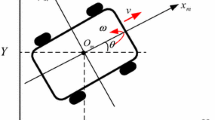Abstract
In this paper, we study the process of controlling the rotation of an object relative to a rotating base using a two-stage electric drive that represents two gearless direct-current motors connected in series. The stator of one of the electric motor is rigidly fixed to the base while an object is fixed to the rotor of the other motor. Between the rotor and the stator of the second motor, there is a torsion spring (torsion) with a relatively low level of stiffness. The aim of the control is tracking by an object a specified orientation relative to the base. The drive control algorithm is built taking into account the incompleteness of the information on the dynamic parameters of the mechanical system, friction acting in it, laws of motion of the base, and changes in the tracked orientation.











Similar content being viewed by others
REFERENCES
Automatic Rotary Vibration Protection Platform. https://ru.wikipedia.org/wiki/.
A. E. Borisov, A. I. Ivanov, S. V. Fedoseev, et al., RF Patent No. 2369535, A method for optimizing the dynamic operating conditions of gravitationally sensitive installations under conditions of residual microaccelerations on orbiting spacecraft board and a device for its implementation, Request No. 2008107131/11, Byull. Izobret., No. 28 (2009).
A. E. Borisov, A. I. Ivanov, and G. A. Emel’yanov, “Swivel platform to stabilize the angular position of the technological installation by the micro-acceleration vector,” in Proceedings of the 46th Scientific Readings in Memory of K. E. Tsiolkovsky (Nasha Tipografiya, Kaluga, 2011), pp. 124–125.
A. E. Borisov, V. L. Levtov, V. V. Romanov, and N. V. Tarasenko, “A set of technical means for providing the controlled environment for research in gravitation sensitive systems,” Kosmonavt. Raketostr., No. 4, 168–173 (2007).
A. Yu. Ishlinskii, Orientation, Gyroscopes and Inertial Navigation (Nauka, Moscow, 1976) [in Russian].
L. D. Akulenko, N. N. Bolotnik, A. E. Borisov, A. A. Gavrikov, and G. A. Emel’yanov, “Control of the apparent acceleration of a rigid body attached to a movable base by means of a two-degree-of-freedom gimbal,” J. Comput. Syst. Sci. Int. 51, 339 (2012).
L. D. Akulenko, N. N. Bolotnik, A. E. Borisov, A. A. Gavrikov, and G. A. Emel’yanov, “Quasi-optimal control of rotation of a rigid body about a fixed axis taking friction into account,” J. Comput. Syst. Sci. Int. 54, 331 (2015).
I. M. Anan’evskii and T. A. Ishkhanyan, “Control of a turntable on a mobile base in the presence of perturbations,” J. Comput. Syst. Sci. Int. 55, 483 (2016).
I. M. Anan’evskii and T. A. Ishkhanyan, “Control of a double-cascade electromechanical system subject to perturbations,” J. Appl. Math. Mech. 80, 361–368 (2016).
M. G. Chilikin and A. S. Sandler, General Course of Electric Drive (Energoizdat, Moscow, 1981) [in Russian].
L. D. Akulenko, S. K. Kaushinis, and G. V. Kostin, “The effect of dry friction on the motion control of electromechanical systems,” Izv. Akad. Nauk, Tekhn. Kibernet., No. 1, 65–74 (1994).
Ya. Z. Tsypkin and P. V. Bromberg, “On the degree of stability of linear systems,” Izv. Akad. Nauk SSSR, Otdel. Tekh. Nauk., No. 12, 1163–1168 (1945).
G. M. Chernyavskii and A. A. Chernov, Laser Systems in Cosmos (Radio Svyaz’, Moscow, 1995) [in Russian].
L. D. Akulenko, “A quasioptimal algorithm for detecting and determining maneuver parameters of a dynamic object,” J. Comput. Syst. Sci. Int. 41, 207 (2002).
Funding
This work was partially supported by the Russian Foundation for Basic research, project no. 17-01-00538 in accordance with state assignment AAAA-A17-117021310387-0.
Author information
Authors and Affiliations
Corresponding author
Additional information
Translated by A. Ivanov
Rights and permissions
About this article
Cite this article
Akulenko, L.D., Bolotnik, N.N., Borisov, A.E. et al. Orientation Control of an Object on a Rotating Base by Using a Two-Stage Electric Drive. J. Comput. Syst. Sci. Int. 58, 829–843 (2019). https://doi.org/10.1134/S1064230719060029
Received:
Revised:
Accepted:
Published:
Issue Date:
DOI: https://doi.org/10.1134/S1064230719060029



